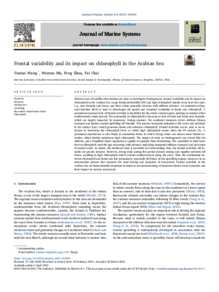Document
Frontal variability and its impact on chlorophyll in the Arabian Sea.
Identifier
DOI: 10.1016/j.jmarsys.2021.103545
Source
Journal of Marine Systems. v. 218, 103545
Contributors
Country
Netherlands.
Publisher
Elsevier B.V.
Gregorian
2021-06-01
Language
English
Subject
English abstract
Sixteen years of satellite observations are used to investigate frontogenesis, frontal variability and its impact on chlorophyll in the Arabian Sea. Large frontal probability (FP) and high chlorophyll mainly occur near the coast, e.g., near Somalia and Oman, and their values generally decrease with offshore distance. An empirical orthogonal function (EOF) is used to disentangle the spatial and temporal variability of fronts and chlorophyll. A prominent seasonal cycle of frontal activities is identified for the entire coastal region, peaking in summer when southwesterly winds prevail. The seasonality of chlorophyll is the same as that of wind and fronts near Somalia, which are largely impacted by monsoons. During summer, the southwest monsoon drives offshore Ekman transport and induces coastal upwelling off Somalia. This process transports subsurface cold water and nutrients to the surface layer, which generates fronts and enhances chlorophyll. Frontal activities can be used as an indicator to determine the chlorophyll level, at which high chlorophyll occurs when the FP exceeds 2%. A prominent dependence is also found in anomalous fields, in which strong winds can induce more frontal activities, which further introduces high chlorophyll. The impact of wind on frontogenesis can extend 800 km offshore, and a simplified linear regression is applied to quantify their relationship. The variability in wind leads that in chlorophyll, with the lags increasing with distance, indicating horizontal offshore transport and advection of coastal water. In winter, the northeast wind is favorable for downwelling; thus, the frontal activities off Somalia are greatly reduced. However, strong wind during this period induces mixing and supplies nutrients off Oman, resulting in high chlorophyll, which extends southwestward along the coast. Thus, the relationship between chlorophyll and fronts was less pronounced, especially off Oman. In the upwelling regions, fronts act as an intermediate process that connects the wind forcing and responses of ecosystems. Frontal activities in the Arabian Sea are fundamentally important to improve our understanding of monsoon-related ocean dynamics and their impact on marine ecosystems.
ISSN
0924-7963
Category
Journal articles

